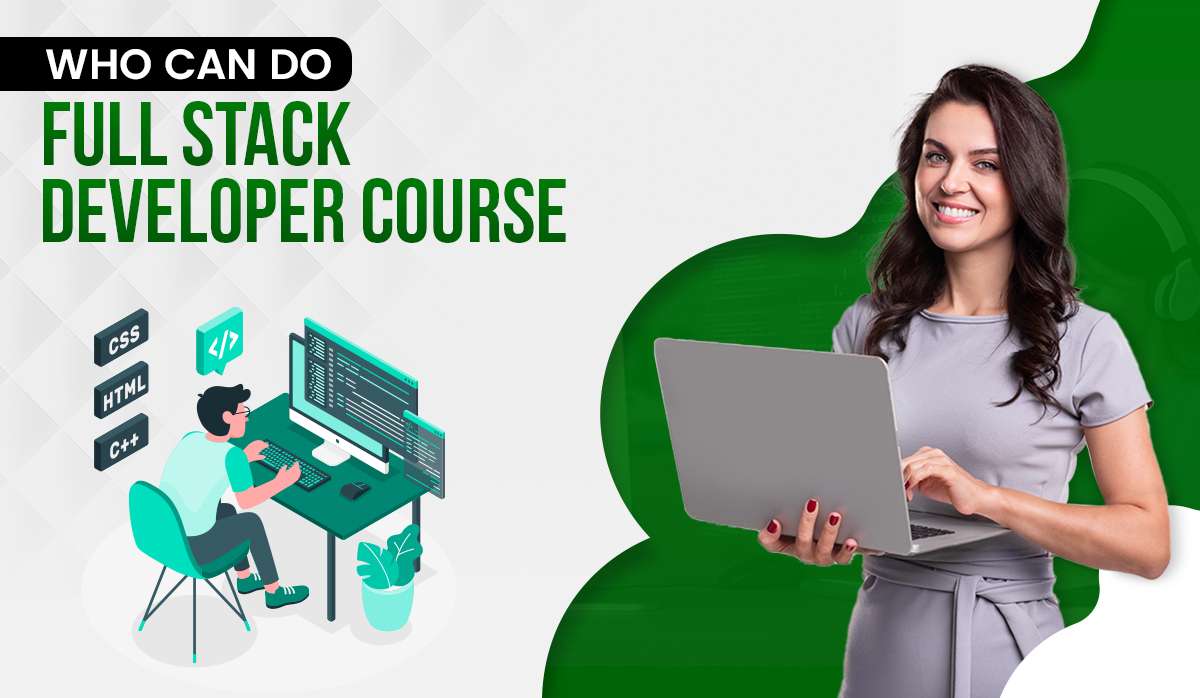A full-stack developer course is open to anyone interested in web programming. The ability to work on a web application’s front-end and back-end modules is called full-stack development. This covers understanding back-end technologies like databases, server-side programming languages, frameworks and front-end technologies like HTML, CSS, and JavaScript.
You can earn a high Full Stack Developer Salary in India by engaging in full-stack development.
The typical target audience for full-stack developer courses is someone who wants to learn or advance their front-end and back-end development skills. These programmes may be appropriate for:
1.) Beginners: People new to web programming want to know the fundamentals of front-end and back-end technologies.
2. ) Front-end Developers: Front-end technology specialists who want to expand their knowledge of back-end development.
3. ) Back-end Developers: developers mostly engaged in server-side programming and wish to become knowledgeable and skilled in front-end technologies.
4. ) Web Designers: designers who wish to expand their knowledge of the development process and add programming skills to their skill set.
5. ) Career Switchers: those who want to shift from a non-technical background to a job in web development.
Full stack development is a large field. Hence the specific course material and prerequisites may differ. Consider your goals, skill level, and preferred learning methods while selecting a course.
What degree does a full-stack developer need?
Having a specific degree to work as a full-stack developer is optional. Some employers may prefer a formal education in computer science or a closely related discipline. However, many full-stack developers learn their abilities through self-study, coding boot camps, online courses, and hands-on experience.
A full-stack developer can pursue the following educational avenues:
1. ) Computer Science Degree: A thorough understanding of computer systems, algorithms, programming languages, and software development techniques can be obtained with a bachelor’s or master’s degree in computer science or a closely related discipline. Building a solid foundation in computer science principles and problem-solving abilities can be helped by this formal education.
2. ) Information Technology Degree: An IT programme can cover various technological topics, such as programming, databases, web development, and software engineering. Even while it might not have a complete stack development focus, it might nonetheless offer useful information and abilities.
3. ) Coding Bootcamps: Coding boot camps are intensive, brief training courses emphasising real-world application. These courses frequently focus on full-stack web development and provide hands-on training. Bootcamps can be a quicker way to acquire the required skills than a standard degree programme. They often teach both front-end and back-end technologies.
4.) Online Courses and Tutorials: Online platforms and websites abound that provide full-stack web development courses and tutorials. These tools let users learn at their own pace and frequently offer a mix of video lectures, coding challenges, and projects to help users practise and show off their knowledge.
The practical knowledge and skills you have in full-stack development are ultimately what matters the most. Building a solid portfolio of projects and showcasing your capacity to create full-stack applications can be just as valuable as having a particular degree, if not more so. Success as a full-stack developer depends on lifelong learning, remaining current with industry trends, and obtaining practical experience.
The Most Important Advice for Becoming a Full Stack Developer
A growth attitude, technical expertise, real-world experience, and practical knowledge are necessary to become a full-stack developer. Here are some crucial pointers to support you on your travels:
1. ) Master Front-End Technologies: Start by becoming familiar with fundamental front-end technologies like JavaScript, HTML, and CSS. Learn about libraries and frameworks like React, Angular, and Vue.js. UI/UX principles and responsive web design are understood.
2. ) Learn Back-End Technologies: Become proficient in back-end technologies such as web application frameworks (such as Express, Django, and Ruby on Rails), databases (such as SQL or NoSQL), and server-side programming languages (such as JavaScript with Node.js, Python, Ruby). Recognise ideas like server-side rendering and RESTful APIs.
3. ) Understand Databases: Learn excellent database design and interaction techniques. Study ideas like relational databases (like MySQL and PostgreSQL) and NoSQL databases (like MongoDB, and Firebase) as well as data modelling. Learn about indexing, data normalisation, and database query languages.
4.) Build Projects: Build full-stack projects that combine front-end and back-end technologies to get experience. Start with easy tasks and work your way up to more difficult ones. This will enable you to use your skills, pinpoint your weaknesses, and demonstrate your talent to potential employers or customers.
4. ) Version Control: Learn how to manage your code using version control tools like Git. Recognise ideas like merging, branching, and collaborating with a team.
6.) Continuous Learning: Keep up with the most recent tools, frameworks, and trends in web development. Since full stack development is a discipline that constantly changes, adopt a philosophy of lifelong learning. Follow industry blogs, join online communities, and participate in coding challenges or hackathons to enhance your skills.
7. ) Collaborate and Network: Participate in meetups and conferences, join online coding groups, and converse with other developers. You can progress as a developer and create possibilities for learning and professional relationships by working with others and asking for feedback.
8.) Problem-Solving Skills: Improve your ability to solve problems. When faced with difficulties, break down challenging activities into small steps, systematically debug issues, and use resources like documentation, communities, and online forums.
9. ) Communication and Soft Skills: Effective communication is essential in every development position. Improve your capacity to communicate ideas, work with others on a team, and comprehend client needs. A well-rounded professional has improved soft skills, including teamwork, time management, and flexibility.
10.) Build a Portfolio: Make a website portfolio to display your work, abilities, and expertise. Links to your GitHub and other code repositories should be included. You can make an impression on prospective clients or employers by building a great portfolio.
Always keep in mind that becoming a full-stack developer is a lifelong endeavour. Accept learning as a process, keep practising, and remain receptive to novel ideas and difficulties.
In addition to learning full-stack development from Kochiva, people may also learn online. How much time is required to master the Python language?










